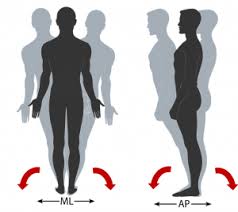 Postural control refers to the maintenance of body posture in space.
Postural control refers to the maintenance of body posture in space.
It is defined as achievement in the maintenance or regulation of balance during any static posture or dynamic activity for the regulation of stability and orientation.
The CNS interprets sensory input to produce motor output that maintains upright posture.
Sensory information used for postural control largely comes from visual, proprioceptive, and vestibular systems.
The ability to regulate posture is mostly an automatic task, controlled by circuits in the spinal cord and brainstem, but cortical areas are also involved, updating motor commands based on the state of the body and environment.
Stability refers to maintenance of the center of mass within the base of support.
Orientation refers to maintenance of relationship within the body segments and between body and the environment for the task.
Two postural control strategies exist: predictive and reactive, utilizing the feed forward and feedback postural controls, respectively to maintain stability.
Feed forward postural control is the postural adjustments made in response to the anticipation of a voluntary or a self-generated movement that may be destabilizing.
Feedback postural control refers to the postural adjustments made in reaction to sensory stimuli from the externally generated perturbation.
Such strategies may involve either a fixed-support or a change-in-support response depending on the intensity of the perturbation.
Postural control involves a complex interaction of multiple systems in order to maintain stability and orientation:
Musculoskeletal components
Neuro muscular synergies
Individual sensory systems: visual, vestibular and somatosensory system
Sensory strategies
Anticipatory mechanisms
Adaptive mechanisms
Internal representations
The functional task and the environment define the precise organization of the postural systems.
Postural control reflexes
Reflexes aid in postural control.
Feedback systems in limb postural control refers to stretch reflex, consisting of sensory neurons that detect external perturbations and activate motor neurons that produce movements that counter the imposed movement.
In some cases, a resistance reflex is reversed in certain contexts, becoming an assistant reflex, causing movement in the same direction as the perturbation.
Postural control was regarded an automatic response to sensory stimuli generated by subcortical structures such as the brainstem and spinal circuits.
Recent evidence from numerous neurophysiological and neuroimaging studies suggests cortical involvement in postural control and maintenance of balance.
Neurophysiological studies reveal an initial postural reaction on exposure to an external perturbations is generated by the brainstem and spinal cord followed by the later part of the reaction which is modified by direct transcortical loops.
The cerebral cortex via cerebellum helps in adapting by using prior experience or via basal ganglia which helps generating a response based on the current context that modifies the postural response.
Neuroimaging studies confirms the pivotal contribution of cerebellar vermis in maintenance of standing posture and involvement of the visual association cortex in controlling postural equilibrium while standing.
There is increased engagement of higher cortical structures noted with increase in demands of locomotor tasks.
Using FMRI it is found that standing is associated with activation of the thalamus, basal ganglia, and cerebellar vermis.
